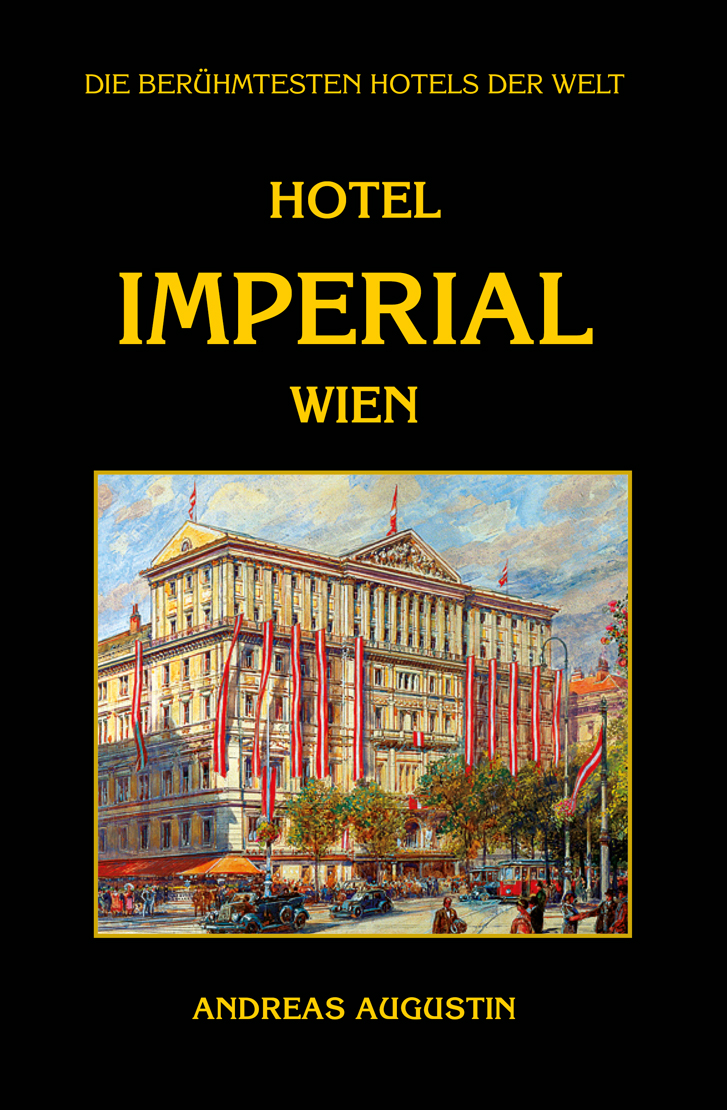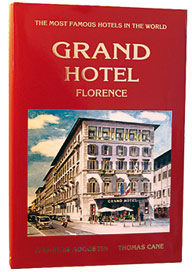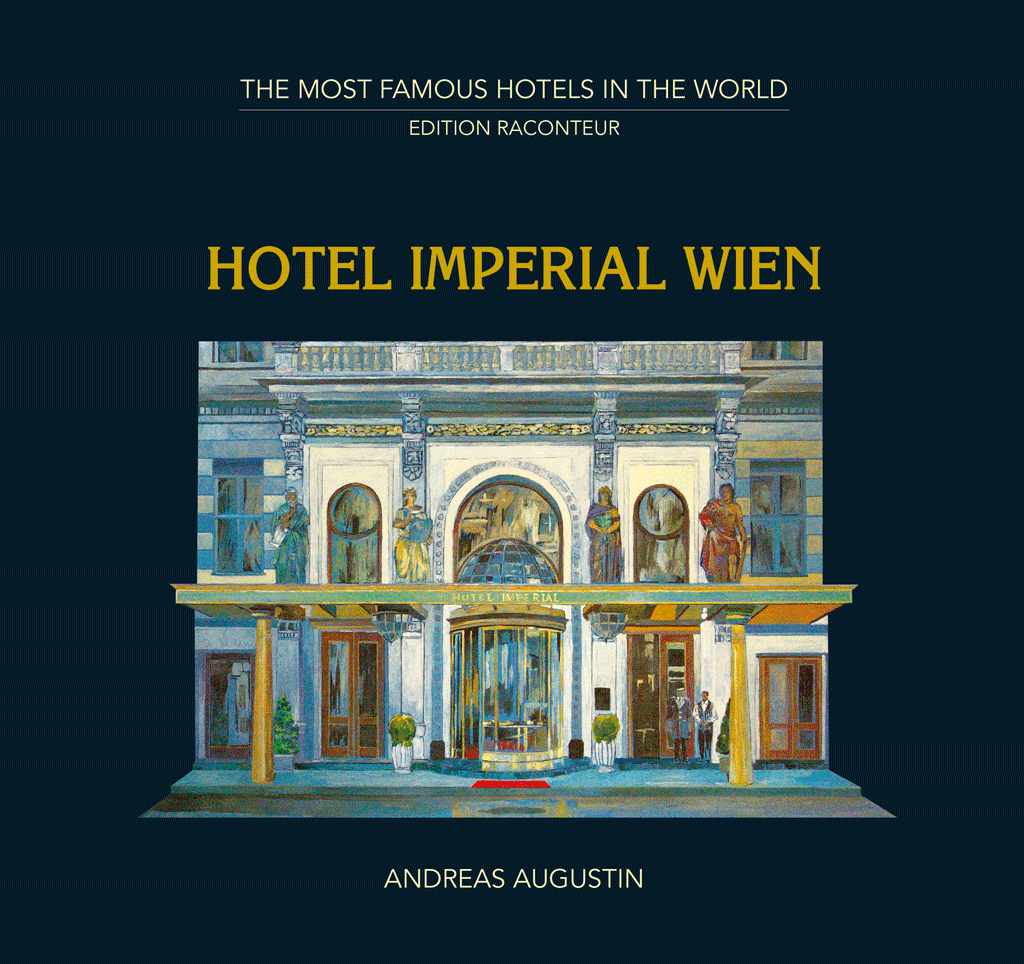Goldener Hirsch – Salzburg, Austria (English Leather Edition)

Author
Andreas Augustin
Pages
160
Photographs
Illustrations
250 historic and contemporary photographs (Bill Lorenz)
Leather-bound edition
Yes
Binding
Leather bound / gold stamping
ISBN
3-900-692-07-6
Size/Weight
160 x 235 mm, 800 g
Related Hotel
Price: € 133.00
Add to cartSince 600 years the Goldener Hirsch is a landmark of Salzburg, of Austria!
This book tells the story of this hotel and the history of Salzburg: from Roman days to Italian tenors, from Mozart to The Sound of Music. Read the history of the Salzburg Festival, the unplanned success of The Sound of Music, its enormous impact on tourism and know all about this 600 years old building!
The hotel Goldener Hirsch opens its secret archives. On 160 pages with over 250 historic pictures, illustrations and contemporary photographs, we meet the makers and shakers of this unique success story and the famous clientele of the house, from Mozart's son Franz Xaver to the Prince of Wales.
From Salzburg you know 'Silent Night, Holy Night', Mozart and the Festival. In 1998, The Most Famous Hotels in the World were commissioned by Erhard Noreisch, general manager of the Imperial Austria Hotels (Starwood), to research the history of the Hotel Goldner Hirsch in Salzburg. I shall never forget the face of the hotel's former general manager, Johannes Walderdorff, when I told him that I have unearthed the first mentioning of the hotel's building at a local archive: it mentioned the year 1407.
Fast forward: in 1756, 349 years later, Mozart was born in Salzburg, not far from the Goldener Hirsch. In 1792, a poor seamstress gave birth to a son in Salzburg’s Steingasse. His name was Josef Mohr, and by today’s standards he would be eligible for millions of dollars in royalties: he wrote the lyrics to ‘Silent Night’. Another 164 years later, in 1920, the Salzburg Festival was founded, today one of the financial backbones of the city. The Goldener Hirsch was a middle class hotel, an inn, with a pub downstairs and a few rooms above it. Its heydays came, when in 1939 Harriet Walderdorff bought the hotel. She had to wait until the end of World War II to run it. Amidst the difficult circumstances of the post war period Harriett Walderdorff began to extend the old hotel. Instead of opting for easy and modern solutions, Harriett Walderdorff created a country residence within the city, elevated to nobility by its service and interior.
In the beginning other Salzburg hoteliers even objected to a luxury hotel having apartments with softwood floors and country-style furniture. A hotel featuring traditional Salzburg rag-rugs instead of Persian carpets was considered to be defrauding one’s guests. But Walderdorff stuck to her guns. She wanted to create a homely style, not a small Grand Hotel, which in her eyes would border on the ridiculous. Naturally, it was also a question of limited financial means.
The exterior walls had to be a particular shade of pink. The hotel’s rustic style became the yardstick for the hotel industry in western Austria. These days no hotel in Salzburg, Tyrol or Vorarlberg would choose to do it any other way.
On 28 April 1948 Harriet Walderdorff opened her “Goldener Hirsch”. Unable to find a hotel director she had to throw herself in at the deep end. Together with a headwaiter called Hallemann, who’d originally applied for the porter’s position, and a baker, a kitchen maid, a chamber maid and girl-Friday Leo, she opened her doors to the public.
Initially, the hotel’s success was directly linked to the success of the city of Salzburg. On the one hand Salzburg had its Festival with musical talent such as Furtwängler, Böhm and Karajan.
On the other hand there was Maria von Trapp, whose personal history led to a famous book, a musical and several films. The name was 'Sound of Music'. Maria von Trapp was promised three eighths of a percent of all the royalties (let me help you: it's 0,375%). Composers Rodgers and Hammerstein were hired. At that time they couldn’t know that they were about to begin working on what was to become their biggest success. The show premiered on Broadway in December 1959. It was staged 1,443 times, won six Tonys and sold over three million records. Twentieth Century Fox bought the rights, Robert Wise (West Side Story) directed the film. Filming began in Salzburg during May 1963 and the festival city quickly became a favourite holiday destination for American tourists. The economic benefits that The Sound of Music brought to Salzburg were – and still are – tremendous. About 50% of the film’s eight million Dollar budget flowed directly into the city’s economy (at that time:1US$ was €1,80 so it came to €14,4m). When The Sound of Music received five Academy Awards, the number of American tourists doubled to 135,000 within the space of five years. There is only one song in the entire history of music that has sold more copies than 'Edelweiss' and that’s 'White Christmas' by Bing Crosby. The film itself is one of the top three in cinematic history. It has made Austria and Salzburg so attractive to Americans that three out of four US tourists (totalling 650.000 every year) state that The Sound of Music is their chief reason for visiting the city on the Salzach.
The effect on the Hotel Goldener Hirsch was obvious. While its rustic country atmosphere became fashionable, its food drove everybody to its doors. Harriet Walderdorff had collected the best menus from all over the world and had started reproducing international fare at her little kitchen. The big season was and is the festival season, two month each summer. After the performance the excited audience rushed from the Festival Hall, hungry for delicious food and the social gatherings that would take place at the Goldener Hirsch. Young and old, famous and not so famous would sit together and wait to have all their senses taken care of, not just their tastebuds.
The Goldener Hirsch celebrates its great artists, installing the tradition that the last act of any performance takes place here. After the final curtain of the Festival had fallen, famous artists – to whom the stage meant everything – crowded into the vault, followed by those people who financed that very same stage. Even the critics, who had sacrificed their holidays to cover the Festival, couldn’t miss this event and always included the celebrations at the Goldener Hirsch in their reports. Comments on the top C were followed by comments on the Paupiette de Veau avec Puree de Pommes de Terre and a Tarte de Linz (veal roulades, mashed potatoes and Linzertorte). One of these critics was Joachim Kaiser of the ‘Süddeutsche’ newspaper. He turned eating a pot filled with crayfish into an event.
During the research I met the late Harriet Walderdorff, who told me all these anecdotes of her life. Even Richard Nixon – at that time still US Vice-President – felt compelled to write a personal letter to the head of the province thanking him for his hospitality and giving special praise to the Goldener Hirsch for its excellent cuisine. ‘The luncheon at the Goldener Hirsch was one of the most well-appointed and delicious I have ever attended, and I hope you will extend my compliments to Countess Walderdorff.’
Shaky times during the 1970s lead to the sale of the hotel. Eventually it became a CIGA Luxury Collection property. Not a bad thing to be. The Goldener Hirsch became the home of the festival actors. Austria’s Hollywood star Claus Maria Brandauer resided here during the Festival. The beautiful Liz Taylor and her husband Richard Burton stayed here for three weeks. Oscar winner Oskar Werner ate and drank here, Pavarotti indulged in gigantic portions of spaghetti, Kirk Douglas enjoyed it, so did the Prince of Wales. Erich Maria Remarque and Paulette Goddard dined here and all of Karajan’s opera premieres were celebrated here – where else?
Queen Silvia of Sweden chatted to the night porter about his dog, Riccardo Muti dined with Margaret Thatcher. After one of his concerts Leonard Bernstein and the New York Philharmonic Orchestra partied at the rustic restaurant ‘Herzl’.
In 1998, 21 CIGA Hotels were incorporated into Sheraton’s ‘Luxury Collection’. As we all know, this became Starwood. This included Imperial Hotels Austria AG with its hotels Goldener Hirsch in Salzburg and Imperial and Bristol in Vienna. Today the Goldener Hirsch new General Manager Herbert Pöcklhofer still welcomes the great names of the stage and industry. While Chef de Reception Erwin Pitzer busily hands out rooms keys, headwaiter Hermann Bauer is an institution who holds the keys to the sacred reservation list of all those much sought after tables during the festival season. Chef Gernot Hicka sends his taste-bud teasers to the big tycoons of the industry and the stars of the stage and the gossip columns like Riccardo Muti and Jessye Norman, Samuel Ramey, Eliette von Karajan and Prince Amyn Aga Khan, Rolando Villazón, Heinz Fischer, President of Austria, the Begum Inaara Aga Khan with GM Pöcklhofer and Renate Thyssen-Henne, St Petersburg starconductor Valery Giergev, Painter and sculptor Markus Lupertz, Baron Eric de Rothschild (Château Lafite) and of course the new darling of the world of opera, Anna Netrebko. Stop dropping names, the Queen told me yesterday! The (almost) complete list is on our website.
The Epilogue of my little book reads: 'Jingle your golden room keys and for one blissful moment you’ll feel as if time has stood still. For six centuries the thick walls of this house have been breathing in history. In every silent corner you feel the heart of this unique hotel. It has been beating steadily for hundreds of years and will surely continue to do so for many centuries to come. It’s time for me to pack my suitcases and to continue on my travels. Dear people and fond memories have been captured in words and pictures. Still, saying goodbye hurts. I comfort myself with the thought that this is not really the end … just the beginning of a new journey.'
How did we go about this research?
This was going to be a very, very long book. After all, there were 600 years of history. I moved into the hotel. Every day I visited the archives of the city, and bit by bit the history of the hotel unfolded. Later Johannes Walderdorff said:
'Somebody like me, who happens to know a lot about the history of his hotel and successfully makes a selling point of this history, is always suspicious about a "stranger" who arrives to research this history again. But the way Andreas Augustin and his team tackle the subject is very impressive. Their research methods are very precise and cover everything from the ancient records of building authorities to interviews with retired members of the staff. No source is left untouched. Their thoughtful formulation of questions always inspires confidence. From the results of all this research a perfect biography of the hotel is composed, taking its place between the prehistory of the country, Mozart and the present.'
The first records to mention the building that now houses the Goldener Hirsch were found at the ‘Nonnberg’ Benedictine convent. They date back to the year 1407 AD. Ten years earlier, in 1397, the Medici Bank was founded in Florence, soon the most powerful bank in Europe. In England The Wars of the Roses took place between York and Lancaster. Around 5,000 people lived in Salzburg. Those were the days of the first permanent trans-European postal route between Vienna and Brussels. In 1492, while Christopher Columbus was discovering America and Vasco da Gama was finding a sea route to India, the Stieglbrauerei, a brewery was founded in Salzburg. Mankind discovered new horizons. Magellan was the first man to sail around the world. Cortez occupied the Aztec empire in Mexico, Pizzaro conquered Peru. California and Canada were reached by the first settlers in 1533, and a first English colony was founded in North America. It was around this time that the first coffee and potato plants were brought to Europe.
The skyline of Salzburg hasn't changed a lot over the past centuries.
Then we were approaching 2007, it's 600 years. 600 years. Can you imagine? How did the Goldener Hirsch (Golden Stag) survive the ups and downs of the centuries.
The answer is simple: it’s always those personalities with a love for detail, the pedantics, those who drive any staff to the edge of reason, that make it into the history books.
Who could forget César Ritz who for weeks on end tested the effect of differently coloured light bulbs on his wife’s complexion. And recall Franz Sacher, one of the great chefs of the 19th century. Day after day he and his daughter-in-law Anna cluttered up the kitchen experimenting with new recipes - or, more contemporary Elisabeth Gürtler, who personally supervised the decoration of this Viennese institution. Or Johannes Badrutt, who founded the winter season at the Kulm of St Moritz by simply inviting his hotel guests. Let us also honour a more recent figure – Kurt Wachtveitl, whose meticulous attention for detail has repeatedly earned the Oriental in Bangkok the title of the best hotel in the world.












